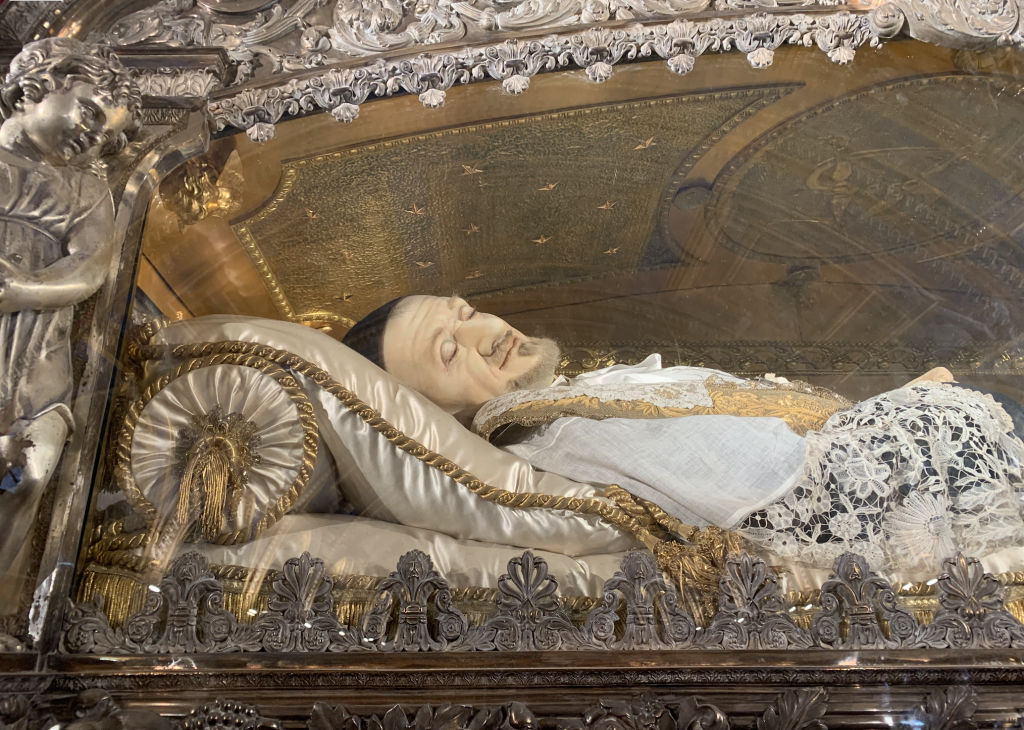Memorial of Saint Vincent de Paul, Priest




“For greater things you were born.” (Ven. Mother Luisita)
Monday, September 27th Lk 9: 46-50 “Whoever receives this child in my name receives me, and whoever receives me receives the one who sent me. For the one who is least among all of you is the one who is the greatest.”
Part One: From Humility to Mercy… by St. Bernard of Clairvaux
Part Two: To Serve is to Reign; To Reign is to Serve by Fr. Ed Broom, OMV
PART ONE… From Humility to Mercy… by St. Bernard of Clarivaux
When in the light of Truth men know themselves and so think less of themselves it will certainly follow that what they loved before will now become bitter to them. They are brought face to face with themselves and blush at what they see.
Their present state is no pleasure to them. They aspire to something better and at the same time realize how little they can rely on themselves to achieve it! It hurts them and they find some relief in judging themselves severely. Love of truth makes them hunger and thirst after justice, and conceive a deep contempt for themselves.
They are anxious to exact from themselves full satisfaction and real amendment. They admit that to make satisfaction is beyond their own powers – when they have done all that is commanded them they acknowledge that they are still unprofitable servants.
They fly from justice to mercy, by the road Truth shows them: “Blessed are the merciful, for they shall obtain mercy. (Mt 5:7) They look beyond their own needs to the needs of their neighbors and from the things they themselves have suffered they learn compassion.
PART TWO… To Serve is to Reign; To Reign is to Serve… by Fr. Ed Broom, OMV
We are building upon the solid structure of the Spiritual Exercises of Saint Ignatius of Loyola, Principle and Foundation: We were created to praise God, to reverence God, and to serve God, and by this means to save our soul. Jesus makes it very clear in Matthew 25: 31-46 that whatever we do to the least of our brothers and sisters, we do to Him! In other words, Principle and Foundation challenges us to go out of our comfort zone, to leave our security blanket, to step out of the boat into the cold water at the Lord’s command so that we can truly serve! May Mary, the humble servant of the Lord, assist us in our true vocation—the vocation that leads to heaven—the vocation of authentic service!
BIBLICAL REFERENCES ON THE VOCATIONAL CALL TO SERVE.
1. SATAN—THE ANTITHESIS OF SERVICE.
It must be said that Satan/Lucifer raised his voice in a clarion call of rebellion against the will of Almighty God with a resounding No to obeying God—Non Serviam!!! I will not serve God. From which a battle ensued against these rebellious angels, who due to their own free-will and determination decided that they would not serve God, or obey God, or submit to His holy will. God marshalled forth Saint Michael the Archangel, the Prince of the Heavenly Hosts, whose name means who is like unto God. The rebellious angels, transformed into hideous and horrendous devils, were expelled from heaven and cast into the fiery pit of hell. (Read Is 14:1-32 – the morning star, son of dawn is Satan/Lucifer; Rev 12 Fall of the Angels – the dragon is Satan/Lucifer and his angels.) In sum, all of the tragedies started, and still start when there is a failure to serve God, a failure to obey God, a failure to submit one’s will to the will of our Lord God, Father and Creator! Sometimes, due to concupiscence and the effects of Original Sin, we battle within our own divided hearts whether or not to submit our will in obedience and service to our Heavenly Father.
2. OUR LADY’S YES TO GOD AND SERVICE.
There could not be a more marked and significant contrast than the Non Serviam (I will not serve) of Satan/Lucifer and the Yes of the Blessed Virgin Mary. Listen to the invitation by the Archangel Gabriel to obey God, to submit her will to the will of God, and to serve God. Mary gives her total consent to the will of the Heavenly Father and becomes, among her many beautiful titles, the Humble Servant of the Lord. Mary’s Yes to God to be His humble servant in all times and places radically transformed the world. Mary said to God through the intermediation of the Archangel Gabriel: “Behold, I am the handmaid (the servant) of the Lord, be it done to me according to thy will.” (Lk 1:38) As a result of Mary’s Yes, “The Word became flesh and dwelt among us.” (Jn 1:14) It is incumbent upon us, in imitation of Mary and her powerful intercession, to give our Yes to God in service. If this is done, we are truly living out Principle and Foundation in our lives in the realm of the universal call to service! May the example and prayers of Mary come to our aid!
3. SERVING IN TWO COMPLIMENTARY WAYS: MARTHA & MARY. (Lk 10: 38-42)
At times Jesus would stop in Bethany to visit three of his good friends, two sisters, and their brother: Mary, Martha and Lazarus. Jesus enjoyed their friendship immensely. On one occasion, Jesus is in their home in Bethany, a town close to the city of Jerusalem. Mary and Martha are present to Jesus but in different ways. Martha is busy with the details of hospitality; we can imagine cleaning, preparing the meal, arranging the table, etc. Mary is simply sitting at the feet of Jesus. What is she doing? Listening to the words of Jesus, talking to Him, possibly asking Him questions, gazing at Jesus, and simply loving the Lord as her Best-Friend. Tense, nervous and somewhat frustrated, Martha asks Jesus to tell Mary to help her. But Jesus comes to the defense of Mary with these words: “Martha, Martha, you are worried about many things; Mary for her part has chosen the only thing necessary and she will not be deprived of it.” (Lk 10: 41,42)
With respect to our call to serve in consideration of Principle and Foundation, this passage with Mary and Martha teaches us a very important lesson: like Martha we are called to serve Jesus and to serve others, very true! However, we should be very careful that we do not to fall into the modern heresy of Activism, or as Pope Saint John Paul II called it Horizontalism, or as Pope Leo XIII termed it Americanism; or if you like, the danger of being transformed into the so called Workaholic! We must serve our brothers and sisters. However, we must never place serving them over giving God our first-fruits, giving God our best. In this same chapter, Lk 10: 25-37, a man asks Jesus what is the greatest of all the commandments. Jesus responds with a question: “What is written in the Law?” The man answers, from the Great Shema of the Old Testament: “You shall love the Lord your God with all your heart, with all your soul, with all your strength, and with all your mind; and love your neighbor as yourself.” In sum, as we delve deeper into Principle and Foundation in our lives, we should examine our conscience—step back and examine our lives to see if we have a bit of the Martha in us, the Activism / Horizontalism / Workaholic tendency… to the detriment of our worship and praise of God. We are definitely called to serve our brothers and sisters, but we are always to put God first, in the very center of our lives. Remember, as creatures of God we are called first to praise God, then comes service of our neighbor. We must perform both, but in the proper order.
4. MT 25: 31-46. OUR FINAL JUDGMENT—BASED ON LOVE & SERVICE. HOW WILL YOU FARE???
Once again, going deeper into the topic of service, we visit and meditate upon the last Parable that Jesus gives us in the Gospel of Matthew 25: 31-46—The Parable of the Last Judgment. The Son of Man, Jesus, will separate the people from one another, as the Shepherd separates the sheep from the goats. He will put the sheep on his right and the goats on his left, representing the saved and damned. Our final judgment and eternal destination will depend on our love for God, but manifested by the love that we show towards our brothers and sisters in need. Jesus could not speak with greater clarity: “Whatsoever you did for the least of my brothers, that you did for me.” (Mt 25: 31-40) Examine your Principle and Foundation, and the key term in this meditation—Service related to the way you are living out the classical Corporal Works of Mercy. How do you fare? For Jesus, love and service are almost interchangeable! Examine your life! Let us take these six Corporal Works of Mercy!
1) “I was hungry and you gave me to eat…” Have you fed the hungry at home or outside your home, anywhere where there has been an opportunity? Saint Mother Teresa, Saint Vincent de Paul, Saint Katherine Drexel, Saint Alberto Hurtado, Saint John Bosco, Saint Joseph Cottolengo and countless other saints saw Jesus in the hungry. To live out Principle and Foundation on Service, how can you feed the hungry?
2) “I was thirsty and you gave me to drink…” From the cross Jesus cried out: “I thirst!” (Jn 19:28) At the well, Jesus asked the Samaritan woman: “Give me to drink!” (Jn 4: 7) In the Parable of Dives and Lazarus (Lk 16:19-31): Dives, the rich man failed to give the poor man, Lazarus, food and drink and consequently Dives suffered the loss of his soul. How can you live out Principle and Foundation, especially Service by slaking the thirst of those around you? Inscribed above the altars on the walls of the sisters of Mother Teresa, Missionaries of Charity, are the words that Jesus uttered from the cross, I THIRST!
3) “I was naked and you clothed me…” Naked can be interpreted as lacking or in need of various things. Many lack dignity, respect, care, concern, compassion, someone to talk to, learning/education, doctrine/catechism, knowledge of the faith. And literally, there are people who lack proper food, clothing and housing. What is your response to the cry of Jesus in the poor of the world? How can you serve the naked? Remember that the conversion of Saint Martin of Tours was triggered by a Roman soldier cutting his cape in half so as to share his cape with a poor man who was half-naked and shivering, lying on the hard, cold ground! Pray over this: how can you alleviate the plight of the many naked of the world; this too is living out Principle and Foundation and our vocation or call to Serve!!!
4) “I was a foreigner and you welcomed me…” Jesus, Mary and Saint Joseph were foreigners; they were exiled immigrants in Egypt. Many of us are immigrants or come from parents or relatives who were immigrants. Remember the Golden Rule and the call to live out Principle and Foundation in Service— “Do to others what you would want others to do to you!” (Mt 7:12) Jesus is present in these people: the lonely, the poor, the neglected, the forgotten, the ostracized, the insulted and misunderstood, the marginalized, the immigrant, the homeless, the deaf and the mute. Remember the words of Jesus, our Lord and Savior: “The Son of man has not come to be served, but to serve and to give his life in ransom for many.” (Mt 20:28) We will be judged on the way we treat and serve others in imitation of Our Lord Jesus, our model.
5) “I was sick and you visited me…” We all know from personal experience how difficult it is to suffer. We all know from experience how challenging and hard it truly is to be sick. Many of us know how hard it is to spend time, days or even weeks in a hospital bed. But at the same time, we all know how consoling, comforting, encouraging and supportive it is when God places a Good Samaritan in our path to help us in our sickness. A kind word and sympathetic gesture—a warm smile, an extended hand or a hug, a fervent prayer—all of these are gestures that can lift us from the valley of tears and darkness to the mountain-peak of hope. By caring for the sick we are living out Principle and Foundation in Service! It is said, “To serve is to reign, and to reign is to serve.”
6) “I was in prison and you came to visit me…” Venerable Archbishop Fulton Sheen on one occasion made a visit to a Prison. He had the opportunity to talk to close to 1000 inmates. He made this startling comment: “We are all prisoners in one way or another. The only difference between you prisoners and me is that you got caught and I did not!” What the saintly Archbishop was really saying is the fact that all of us are sinners, all of us are at times prisoners of our own immoral slaveries. The fact that we are not incarcerated in some County Jail is the grace of God. Saint Philip Neri, seeing a man lying in the gutters of Rome commented: “There go I, save the grace of God.” We are all capable of the most heinous of crimes, commented Saint Therese, the Little Flower, if God’s grace did not sustain us, support us and protect us! Saint Therese also commented with great humility: “The only reason why I did not commit the most heinous of crimes was because God cleared the path for me.” Take a step back and look at your life, at your social milieu, at the people that God places in your path and beg for the grace to recognize those who are really in prison. Maybe you know someone who is a slave to some vice—Drinking, Porn, Drugs, Gambling and Casinos, Compulsive Buying. These people are the modern prisoners; they are prisoners and slaves of their own passions, of their own sins. With respect to Principle and Foundation and once again Service, what can you do to help these people? What can you do to set the captives free??? Or maybe even this is you or me! Let us beg God’s help!
May the Lord Jesus, the Blessed Virgin Mary, and the saints help us to look into our lives and become aware of the many opportunities that God offers us to serve Him in those whom we meet—those with whom we live, and work, and bump shoulders with. These people are really Jesus in disguise.
Copyright 2021 Oblates of the Virgin Mary / St. Peter Chanel Church, Hawaiian Gardens, CA











